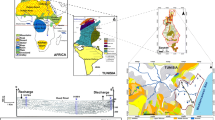Abstract
Groundwater is an important source of water available at any desired location with the requirement of less treatment. Its quality has been declining, which may be ascribed to both anthropogenic activities and gigantic natural processes. Maintaining groundwater quality is a significant issue as still many people depend on it for agricultural and even drinking purposes. The present study pertains to spatial analysis of the groundwater resources of 23 Mandals of Sri Potti Sreeramulu Nellore district located in Andhra Pradesh, a region which has been reported to have fast quality decline. Geological classes belonging to Toposheets numbered 57 M, 57 N, and 57O are used to develop the geology map. More than 90% of the area is underlain by quartzite, gneisses, hornblende schists and mica schists. LISS-III images of IRS P6 Resources at II are used for land use classification. Chemical data of 57 groundwater observation wells evenly distributed in the area has been obtained from Groundwater and Groundwater audit department Nellore, for the year 2016. Spatial distribution maps are developed for each quality parameter of available data for both pre-monsoon and post-monsoon seasons by inverse distance weighted interpolation method using ArcGIS. Even though the wells of pre-monsoon are showing maximum concentrations, its spatial distribution is more in post-monsoon (more than acceptable and permissible limits). It is observed that rock-water interaction is one cause in reducing water quality in some areas. This indicates the source of the groundwater pollution to be geogenic. The study also attempts to tie up the land use classes present in the area to the groundwater quality distribution in the region. So in this study, satellite data from the LISS-III sensor along with the collateral information derived from the field and other sources have been used to identify the sources of pollution behind the quality degradation of groundwater.
Access this chapter
Tax calculation will be finalised at checkout
Purchases are for personal use only
Similar content being viewed by others
References
A.V.S.S. Anand Scientist-C (2013) Groundwater brochure Nellore district, Andhra Pradesh, Central Groundwater Board, Ministry of Human Resources, Government of India
Li P, Qian H, Wu J, Zhang Y, Zhang H (2013) Major ion chemistry of shallow groundwater in the Dongsheng coalfield, Ordos Basin, China. Mine Water Environ 32:195–206. https://doi.org/10.1007/s10230-013-0234-8
Nagaraju A, Thejaswi A, Sreedhar Y (2016) Assessment of groundwater quality of Udayagiri area, Nellore District, Andhra Pradesh, South India using multivariate statistical techniques. Earth Sci Res J. https://doi.org/10.15446/esrj.v20n4.54555
Sudhakar P, Scientist-D (2017) Ground water year book 2016–2017 Andhra Pradesh State, Central Ground Water Board, Ministry of Water Resources, River Development & Ganga Rejuvenation Govt. of India
Tashtoush SM, Al-Subh SA (2015) Interpretation of groundwater quality parameters for springs in Tafileh area in South of Jordan using principal components analysis. Environ Sci 3(1):31–44. https://doi.org/10.12988/es.2015.523
Todd DK, Mays LW (2005) Groundwater hydrology, 3rd edn. Wiley, New York
Wu J, Li P, Qian H (2015) Hydrochemical characterization of drinking groundwater with special reference to fluoride in an arid area of China and the control of aquifer leakage on its concentrations. Environ Earth Sci 73:8575
Acknowledgements
The authors would like to thank our Director Dr. P M Padole, Dean (R & C) Dr. V.B. Borghate, Head CED Dr. Rajesh Gupta, Mr. Mukesh M S, PhD Scholar, Mr. Digambar Sambhaji Londhe, PhD Scholar, Department of Civil Engineering, for their support.
Author information
Authors and Affiliations
Corresponding author
Editor information
Editors and Affiliations
Rights and permissions
Copyright information
© 2022 The Author(s), under exclusive license to Springer Nature Switzerland AG
About this chapter
Cite this chapter
Devalla, U.K., Kumar, V., Katpatal, Y.B. (2022). Gis Approach to Identify the Influence of Rock Water Interaction and Land Use Land Cover on Groundwater Quality Degradation. In: Jha, R., Singh, V.P., Singh, V., Roy, L., Thendiyath, R. (eds) Groundwater and Water Quality. Water Science and Technology Library, vol 119. Springer, Cham. https://doi.org/10.1007/978-3-031-09551-1_33
Download citation
DOI: https://doi.org/10.1007/978-3-031-09551-1_33
Published:
Publisher Name: Springer, Cham
Print ISBN: 978-3-031-09550-4
Online ISBN: 978-3-031-09551-1
eBook Packages: Earth and Environmental ScienceEarth and Environmental Science (R0)




